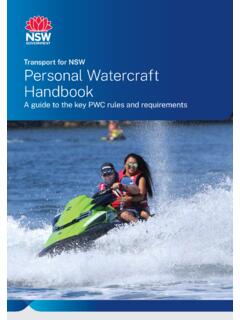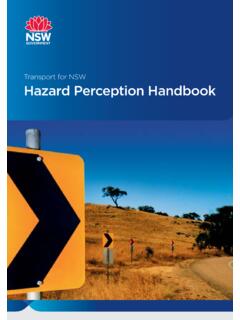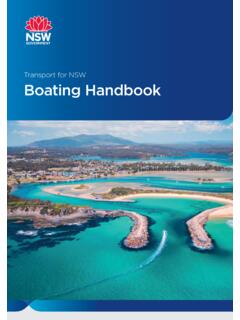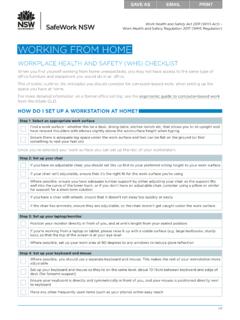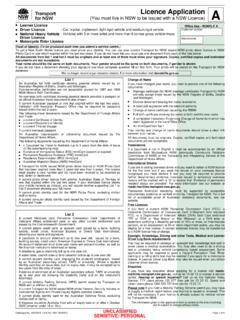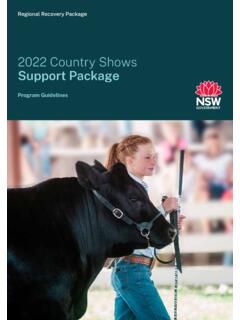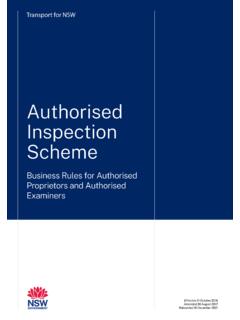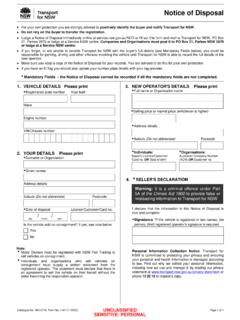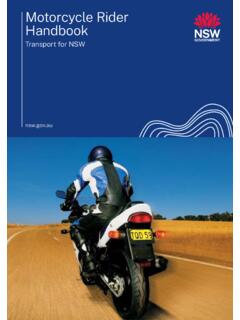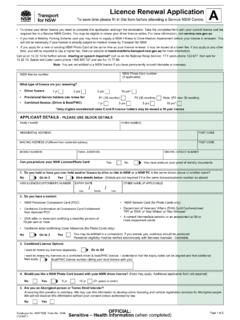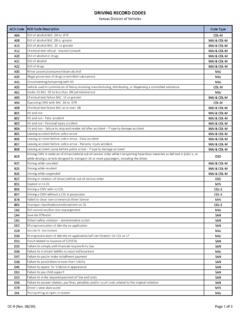Transcription of A Guide to the Driving Test - Transport for NSW
1 A Guide to the Driving TestTransport for NSW Guide to the Driving TestLearner drivers must successfully complete a computer based Hazard Perception Test before attempting the Driving Driving Test is an important step in gaining your driver licence. When you pass you will be issued with your provisional P1 licence and will no longer need to keep a log book or have a supervising driver in the car with you. You will be free to continue learning and gaining valuable experience through Driving on your booklet is a general Guide to the Driving Test. For more detailed information you can read the Driving Test (Class C) Testing Officers Manual. The Road User Handbook is also a useful publication that covers the main road rules you need to know to drive legally and safely on NSW roads. You can access both publications at nsw. you need the current and complete set of Road Rules, visit Guide to the Driving Test2 Introduction 1 The Driving Test 3 The way the test works 3 Before you start 5 Booking the Driving Test 5 Taking the test 6 Low risk Driving 8 Observation 8 Speed management 11 Road positioning 14 Decision making 23 Responding to hazards 25 Vehicle control 29 Operating the controls 29 Test results 31 Why you might fail 31 What happens after the test?
2 38 Tips for new provisional drivers 41 Provisional licence driver restrictions 41 Contents3A Guide to the Driving TestThis Guide explains what you need to do before taking a test, what you will be tested on, and what happens afterwards. The way the test worksThe Driving Test is a set course over 25 zones. A testing officer will be in the car with you to direct the drive and record your performance on a test score sheet. Your test is scored on your ability to show low risk Driving behaviour in a range of situations. The test has five key performance indicators: speed management (S) road positioning (P) decision making (D) responding to hazards (H) vehicle control (C).Hazard presentin the zoneA circle,requirement notdemonstratedS P D Z H R C NOTES123 Signal errorA tick, requirementdemonstratedObservation errorNo hazards presentin the zoneAssessmentsThe Driving TestA Guide to the Driving Test4 Breaking road rules or following other vehicles too closely is high risk Driving behaviour.
3 If you drive this way, you will not pass the test, regardless of your overall back of the Driving Test score sheet explains the test scoring to the Test results section of this Guide for a list of fail items. To pass the Driving Test you must score at least 90 per cent or more with no fail items. In all the diagrams in this Guide you are always the blue car, marked Driving Test5A Guide to the Driving TestLearner drivers must successfully complete a computer based Hazard Perception Test (HPT) before attempting the Driving Test. The HPT is only valid for 15 months. If it has been more than 15 months since you passed the HPT you will need to do the test again before you can do the Driving the Driving TestWhen you are ready for the Driving Test book and pay: online at by calling 13 22 13 at a service change or cancel your booking, you must do this at least 24 hours before the test date or your fee may not be transferred or completed log bookBefore you can take a Driving Test you must have.
4 The required amount of Driving experience recorded in either your Learner Driver Log Book or digital learner driver log book app The Declaration of Completion signed by your supervising driver in your Learner Driver Log Book or submitted electronically from your digital learner driver log book people is against the lawIt is illegal to offer, request or accept gifts, rewards, money or other favours in order to get a licence without passing the required tests . Penalties are severe and include fines and imprisonment. All cases of corruption will be investigated and strong action will be taken against all those involved. Before you startA Guide to the Driving Test6 The only licence fees and charges you have to pay are set by Transport for NSW. Do not pay any more or offer to pay more to get your licence. If you know or believe that someone has got or is about to get a NSW licence by offering or responding to a request for a bribe or if you suspect or know of any other corruption involving a NSW Government employee call Transport for NSW on 1800 043 642 (free call) or the Independent Commission Against Corruption (ICAC) on (02) 8281 5999.
5 Taking the testWhen you go to a testing centre for the Driving Test, you must have a person with you who has a full driver licence. If you fail the test you cannot drive away on your own and will need a licensed driver to be with you. Plan to arrive at a testing centre in good time for your appointment. If you have a Learner Driver Log Book and booking confirmation slip give it to the person at the counter. If you used a digital learner driver log book app, it must submitted at least 24 hours before your test, so you only need to give the booking confirmation slip to the person at the counter. You will be referred to a testing testing officer will ask you to sign the score sheet. Remember to ask any questions before you start. The testing officer cannot tell you how to drive or coach you during the test as it is an assessment of your ability to drive on your own.
6 A monitoring officer may sit in on your test. The monitoring officer s job is to watch the testing officer and make sure that the test is conducted properly. Nobody other than the testing officer and monitoring officer is allowed to be in the vehicle with you during the you start7A Guide to the Driving TestBefore you startTry to relax. You will not be expected to drive as skilfully as an experienced driver. Remember, you can try again if you fail. However, you must wait a minimum of seven days before you may reattempt the Driving the test, the testing officer will review your performance if you wish. Testing officers will provide general comments rather than discuss specific situations or events. If you fail you will receive a Driving Test record that shows where you need to car must be roadworthy and ready to driveBefore the test starts, the testing officer will check the vehicle is suitable and safe for use.
7 Go to the Test results/Test termination section of this Guide for the testing vehicle checklist. The test can be terminated if any item on the list cannot be fixed in time for the test a test can be cancelledIf there is any suspicion you have consumed alcohol or drugs, the test will be cancelled. The test booking fee will not be refunded. If you offer a bribe or try to influence the testing officer, the test will be stopped. The police may be called or you could be taken to the police station and charged with offering a bribe. To avoid misunderstanding make sure all money and valuables in your vehicle are locked away or out of Guide to the Driving Test8 Driving is never risk free, but you should aim to drive low risk . You will be assessed on your low risk Driving skills in speed management, road positioning and decision making. The test also assesses your ability to perceive and respond to is an essential skill for a low risk driver.
8 The testing officer will be assessing your observation techniques throughout the test. You will fail if your observation is is keeping your eyes moving, checking in one area for no more than a couple of seconds and then moving your eyes to another risk drivers constantly scan traffic Driving around corners turn your head and look through the corner scanning the road ahead of your down if vision of the road ahead is will be expected to make regular checks in your rear vision mirror so you know what is happening behind you. You must check your rear vision mirror before you slow down or change direction. When scanning look: in the distance at the road surface to the left and right in your mirrors at the instruments and risk driving9A Guide to the Driving TestLow risk drivingBefore proceeding through traffic lights, you must turn your head and check to ensure there are no vehicles that may be running the red light, or pedestrians crossing against the don t walk sign.
9 You must also turn your head and check to ensure it is safe before proceeding across a railway level blind spotsA car, motorcycle or bicycle in an adjacent lane can easily be positioned beyond the area visible in the mirrors. Checking your blind spots is an essential observation skill as many crashes occur because drivers do not turn their head and look over their shoulder before steering. Frequently not performing observation checks will result in a spot areaACheck blind spots before changing your road spot areaBlind spot areaDo not drive in the blind spot of other Guide to the Driving Test10 Low risk drivingABlind spot areaAll vehicles have a large blind spot behind them. Because of this blind spot, extra care must be taken when reversing as small children can be out of must turn your head and check your blind spots before: changing lanes leaving or returning to the kerb merging or diverging reversing turning left looking for pedestrians, cyclists and motorcyclists who could be beside you in your blind spot turning right looking for vehicles that may be overtaking you joining the traffic stream leaving the inside lane of a multi lane reversing you must turn your head and look over your shoulder to check through the rear window for vehicles and pedestrians that may not be visible in your mirror.
10 All vehicles have blind spots turning left you must check for bicycles and other vehicles that could be in your blind Guide to the Driving TestLow risk drivingABefore turning into a street or driveway you must have a head check for vehicles that may be overtaking errors are recorded on the Driving Test score sheet as a circle around D (decision) and an H in the notes managementYou must drive at a safe and legal speed, managing your speed to suit traffic, weather and road space to the frontYou must adjust your speed to maintain crash avoidance space to the front of your minimum safe distance needed in front is three seconds. This must be increased in poor conditions, or when you are being followed too closely by another vehicle. When you change lanes or if another vehicle moves into your 3-second gap, you will be expected to create a new gap by gradually dropping calculate a 3-second crash avoidance space when following another vehicle use this basic technique: as the rear of the vehicle in front of you passes a stationary object at the side of the road such as a power pole, tree or sign, start a 3-second count one thousand and one, one thousand and two, one thousand and three.
